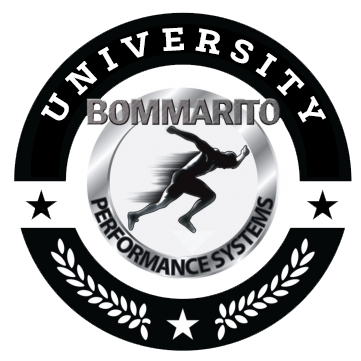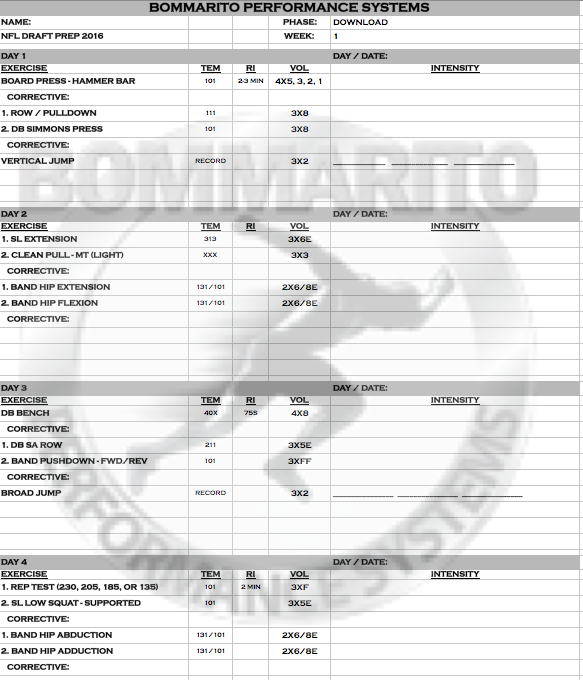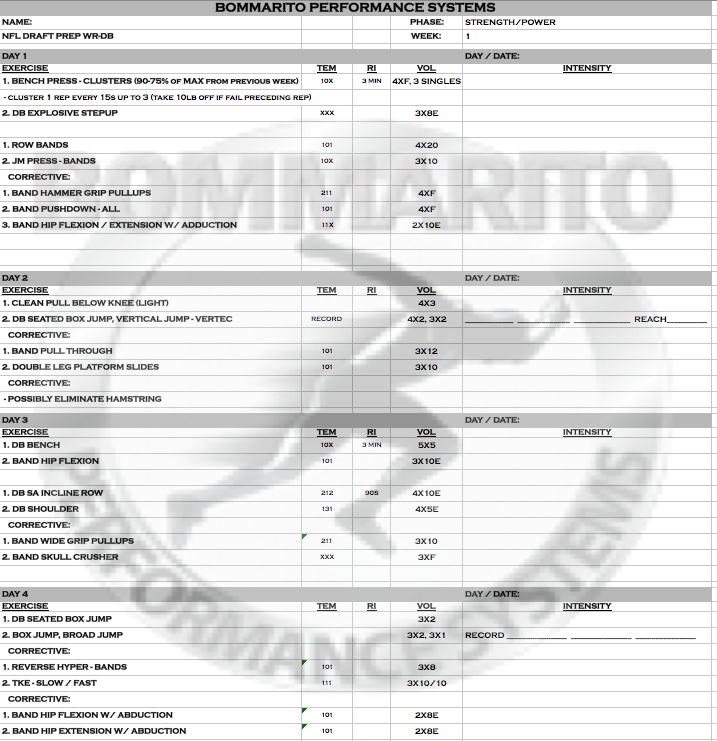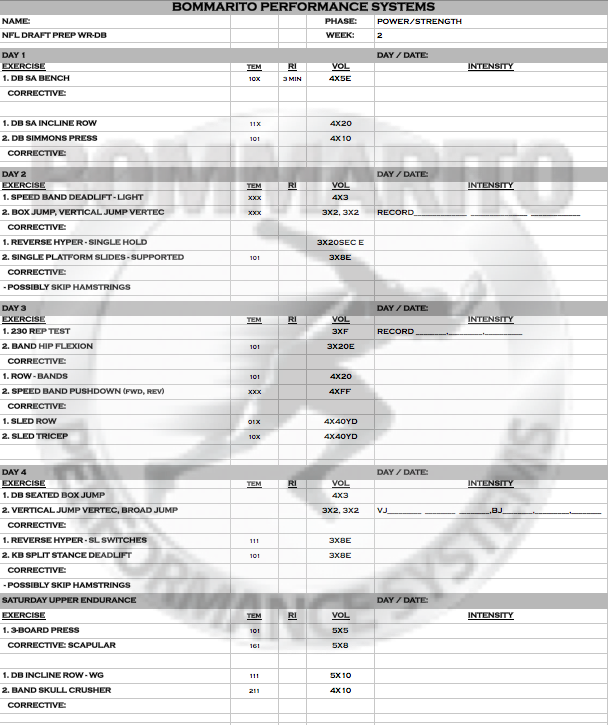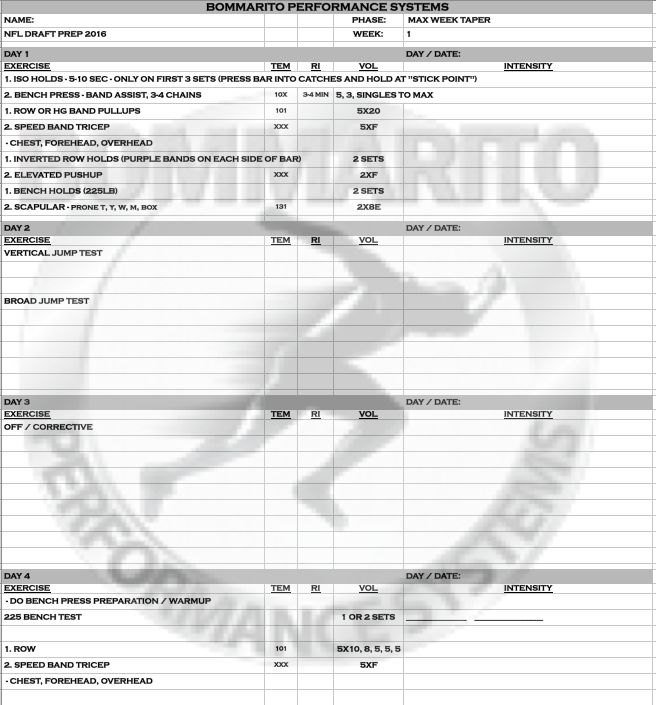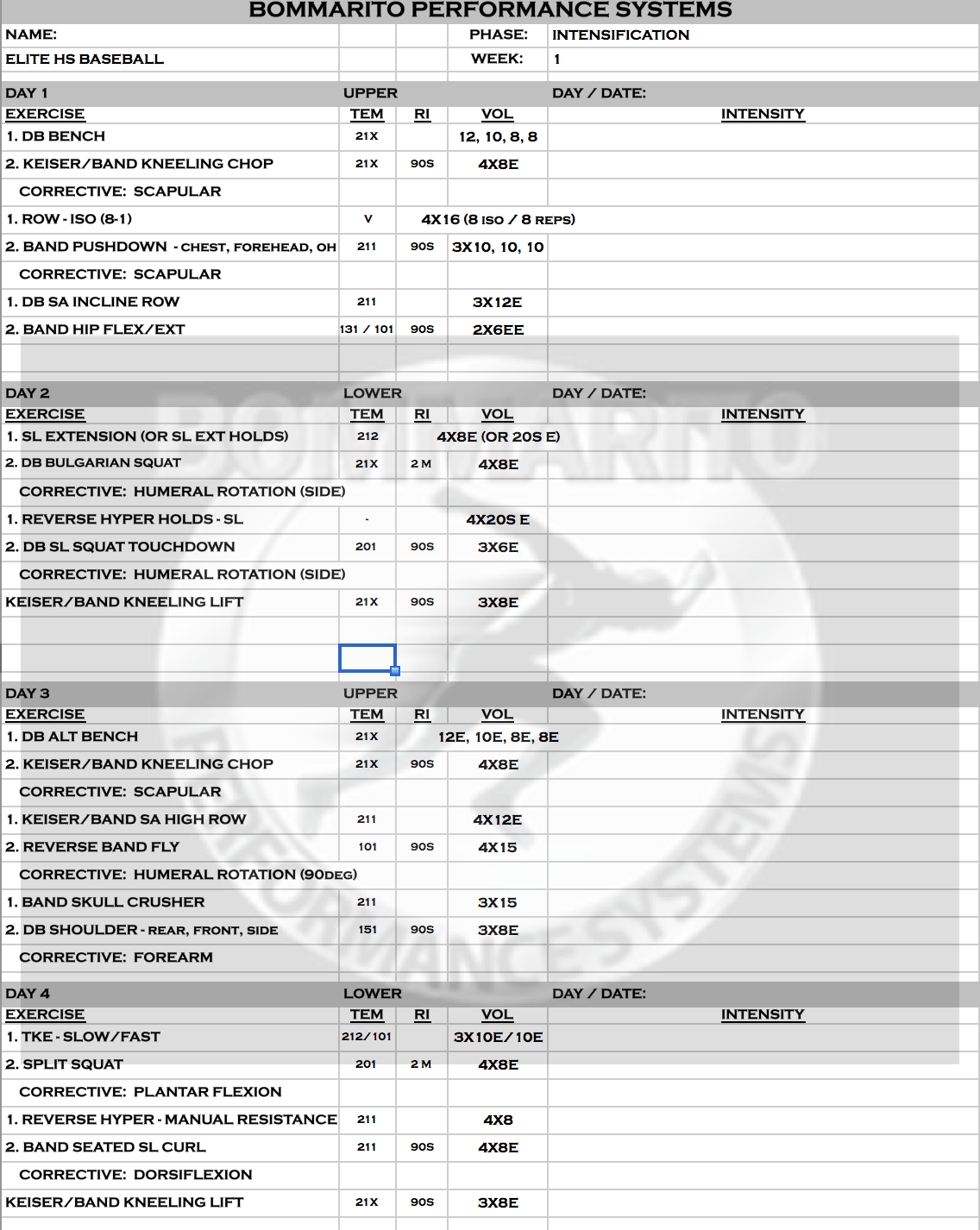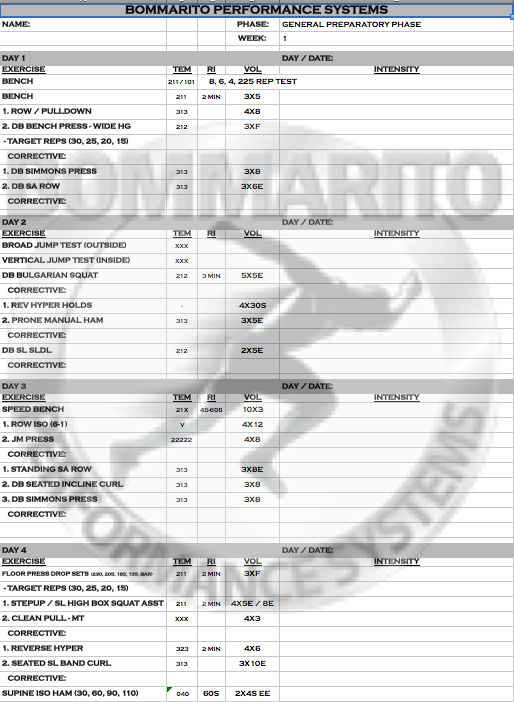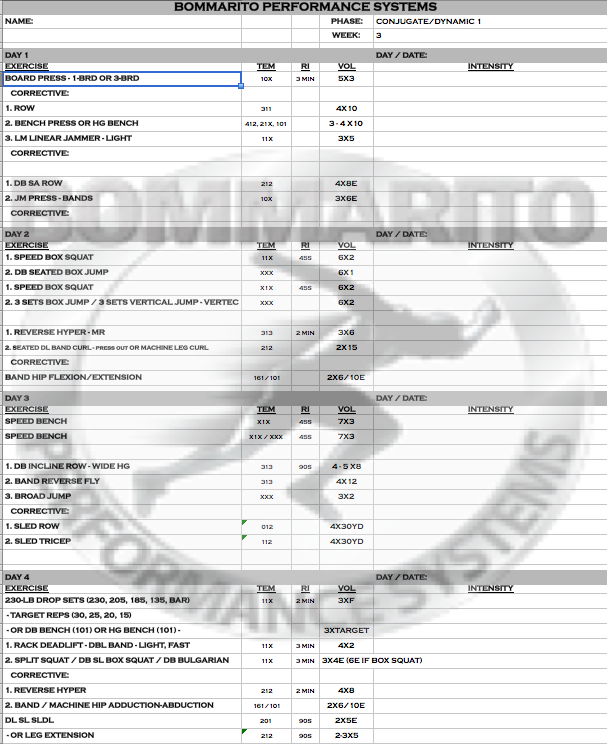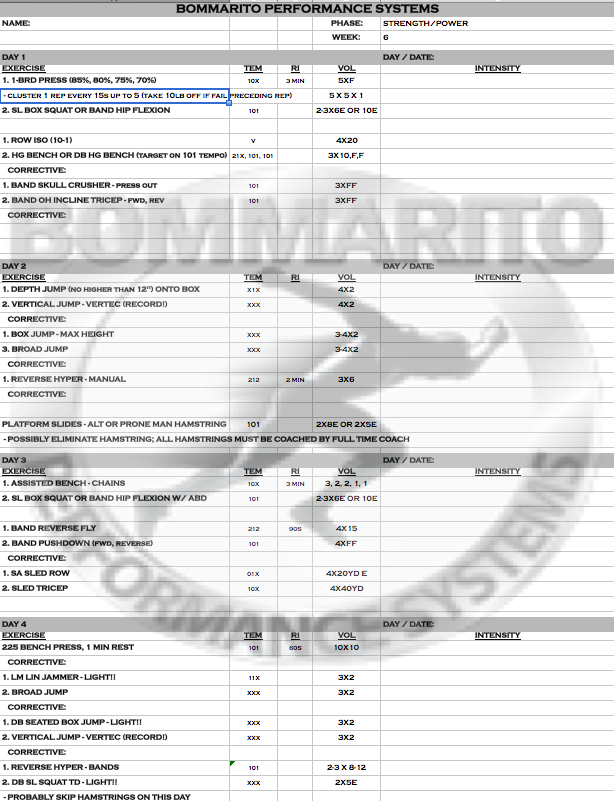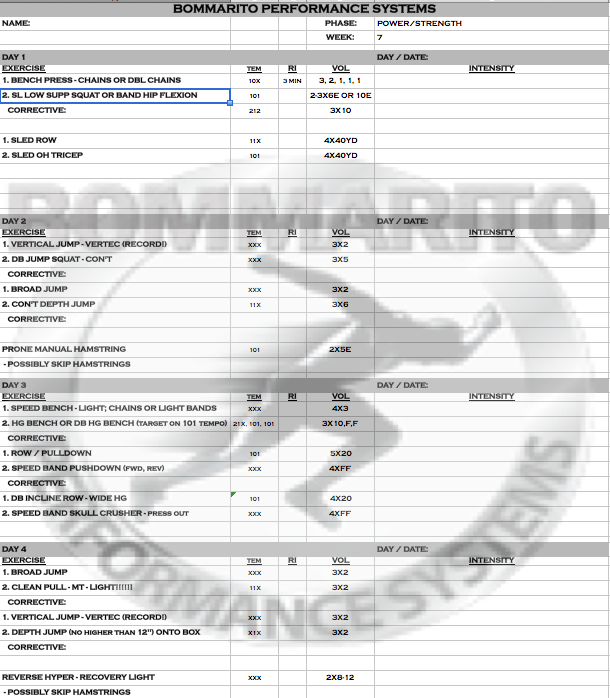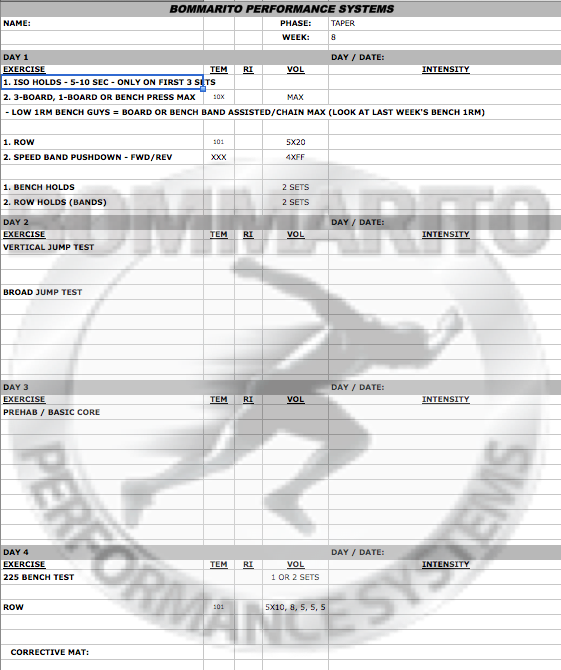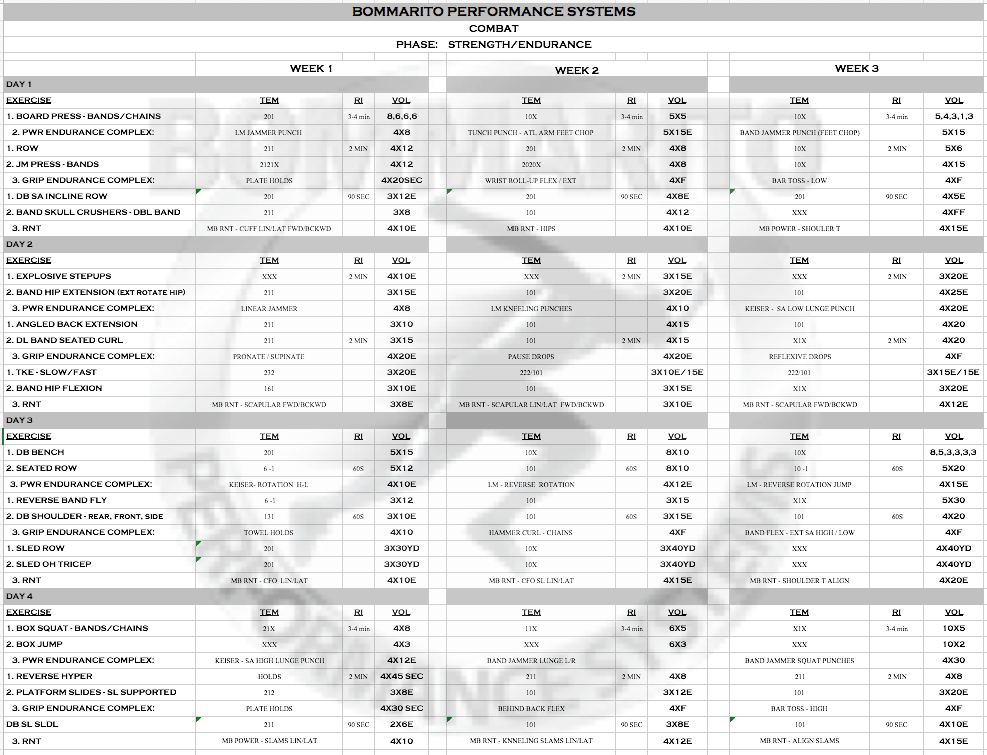Elite football combine prep movement training can be a challenging periodization to plan for since there is a short mesocycle of typically 8 weeks. The goal is to reach the highest genetic potential of speed for each athlete safely but quickly. You will see how we periodize for our combine training down to the week, day, and exercise.
The format we use to lay out the periodization is organized so we can see the day and type of training to the left. Moving to the right you’ll see the aspect of training weather its CAMPS (CNS Activation and Muscle/Joint Preparation Systems), plyometrics, technical drills, or application drills. Our CAMPS are always first and designed to specifically prepare the athlete for the type of training planned for that day. For instance, Mondays and Thursdays are agility days that involve lots of lateral change of direction may dictate that more lateral lunging or hip adduction/abduction focused exercises will be implemented into CAMPS. Plyometrics typically follow CAMPS. Application typically follows the plyometrics and the technical drills are implemented between application drills based on flaws the athlete may present during the application drill. The volume (reps and sets) for each application drill depends on form and injury imitations. Typically, if the athlete is healthy high volume of basic level speed work is recommended in the first week. The focus of Tuesdays and Fridays is linear speed. Wednesday is our active recovery day with the focus on doing speed drills in our Olympic pool. The pool allows us to de-load the joints since the pool water will support half the weight of the athlete.
Week 1 is our general preparatory phase (GPP). In this phase the athletes are medically evaluated to identify imbalances. Our exercises are designed to balance the athlete then progressively overload the body to solidify the bilateral muscle balance. Much of emphasis is put building a base level of strength so the muscles can adapt to basic speed drills. The more high level advanced training is dependent on the base level GPP adaptation to speed training to maximize speed and avoid injury. There is a heavy emphasis on learning technique for agility and 40-yard dash starts. Lots of resistance speed training is utilized to work on the acceleration phase.
Week 2 is our intensification phase. More volume is added to the exercises introduced in the GPP phase. Also, longer buildups into the a-run exercises are added along with more heavy resistance training on acceleration sprint training. In this phase we will introduce phase 1 of assisted sprint training. The assistance will be really short with maybe just for the first step of a 10-yard sprint. This drill is high-risk high reward, which is why there is multiple phases the progress in intensity. Only athletes that are healthy will partake in assisted work.

Week 3 drills progress in volume, resistance, and distance of each drill. Phase 2 of overspeed is introduced with ankling and buttkick drills. The athletes’ muscles are now prepped for higher intensity drills such as phase 2 of over speed.
Week 4 focuses on longer a-run zones with faster build-up runs. Phase 3 of overspeed is now safe to implement. Distance of pulls and runs for overspeed is determined by form and/or medical limitations.

In the 5th week of training volume is slightly decreased with increased intensity being the goal. The amount of drills at this point is limited to 1-2 sets. This means the athletes should perform these sets and reps with aggressive speed and power while maintaining ideal form. Staying with the theme of increase intensity, the overspeed drills are a main goal for the linear days. This is the drill that will help guys get the extra speed needed to lower their 40-yard dash time. Agility drills are performed from start to finish without being practiced in its parts. It’s important that all weight room and muscle preparation exercises before speed work minimizes the hamstring specific drills if not completely avoided. We want the athlete to train hard in week 5 but keeping in mind week 6 is their first mock combine. For athletes invited to Indianapolis NFL combine, this mock will be their true mock combine.

Week 6 is mock combine week. All athletes going to the NFL combine will take this day seriously to closely as possible mimic their testing day at the NFL combine. These athletes will only be about 75-80% recovered at this point due to the week 5 training. Also, this day and the testing numbers that is yielded will just be an estimate for their potential. The athletes’ highest genetic potential should be peaked exactly on their proday or combine testing day, assuming the athletes have no injuries or experience any other unforeseen issues. We typically bring our athletes to the ocean the day after the mock combine-testing day to speed up recovery times. The rest of the week is designed to correct flaws in any of the drills that we videotaped for each athlete on the mock combine day. Also, hamstring exercises are avoided to allow them to recover faster.

Week 7 is one of our last high intensity moderate volume training weeks. By this time athletes are adapted to the stress of overspeed training and running full speed or more than full speed for 30-60 yards. We are confident that all healthy athletes can increase the intensity and volume of their overspeed runs by pulling harder and assisting the sprints for greater distances. Keep a good rest time of around 2-3 minutes between pulls to allow the muscles to recover. On day 1 athletes going to the NFL combine will only do the combine camps and full speed agility drills for about 1-2 sets each. On day 2, their last mock combine may be limited to a maximum distance of 20-yard sprints to ensure their muscles are not over trained. This last mock focuses on perfecting 40-yard dash starts and correcting any flaws from their previous mock combine. All athletes will end the week with full speed agility drills and a low volume linear speed day with possible low volume overspeed sprints.

The final week 8, most athletes are using day 1 to taper down for their true mock combine on day 2. NFL combine athletes are also still tapering down from the previous week since they fly out and travel to Indianapolis. The NFL combine guys do strictly combine camps and practice starts with strategic “off days.” Hydration is a key focus due to weather and surrounding changes that can dehydrate athletes. If the combine athlete follows our taper regimens and does not change the usual routine, he will peak and perform well on his assigned testing day. All other athletes in this final week will perform their day 2 true mock combine followed by a recovery day on day 3. For their final day 4 and 5, most of the athletes will begin their taper sheets and travel to their school and peak on their testing proday.

